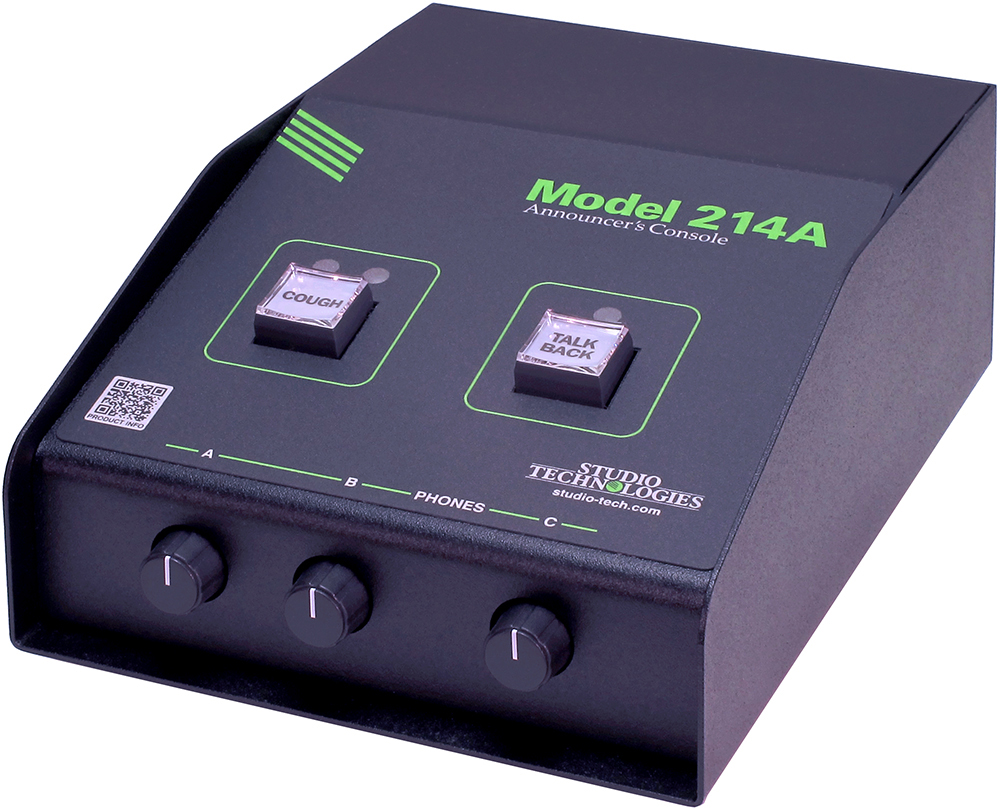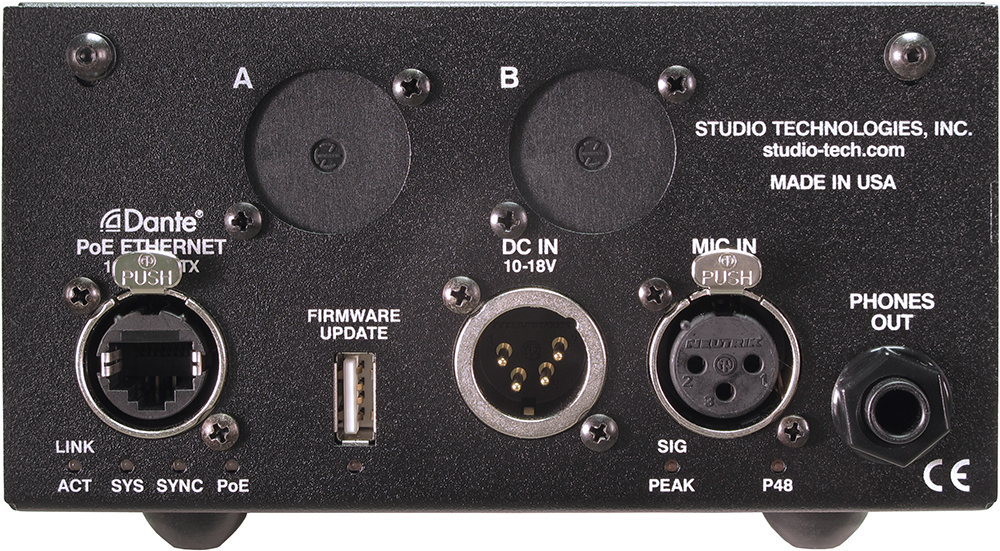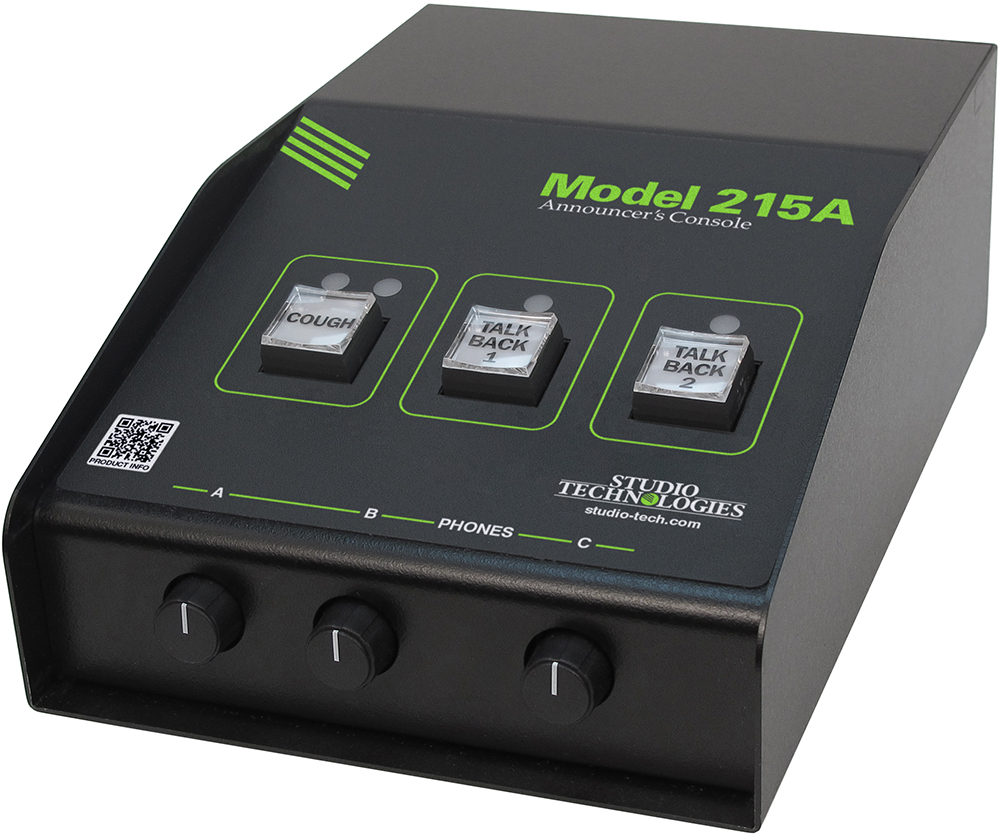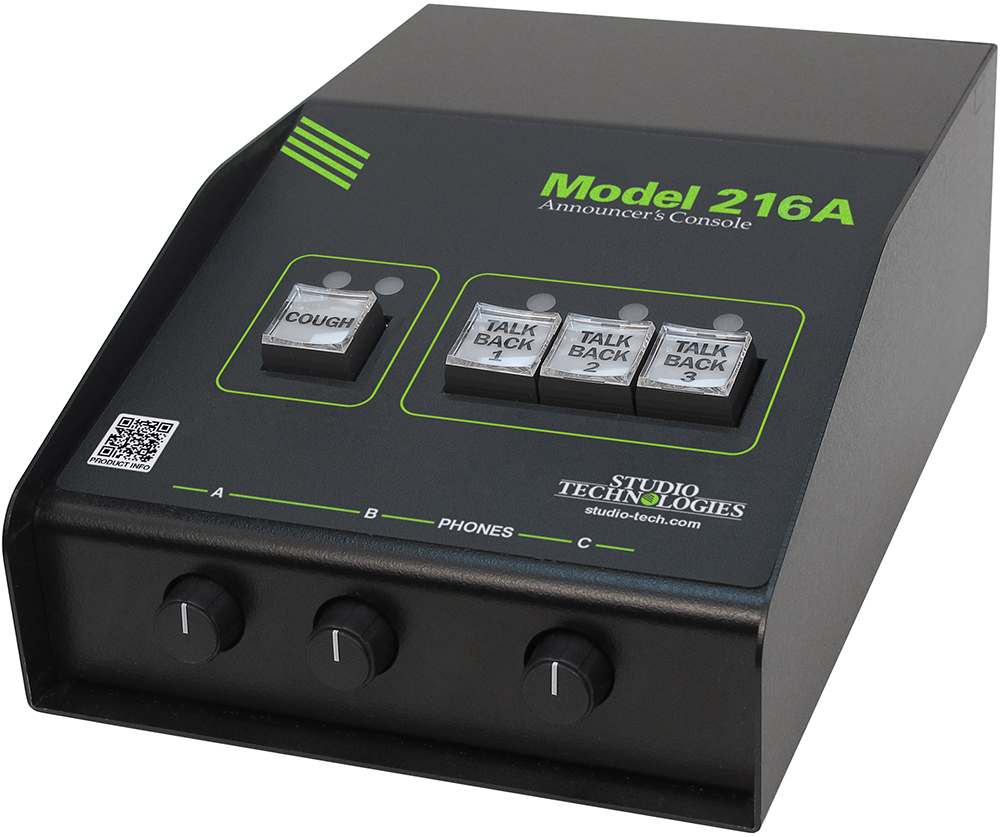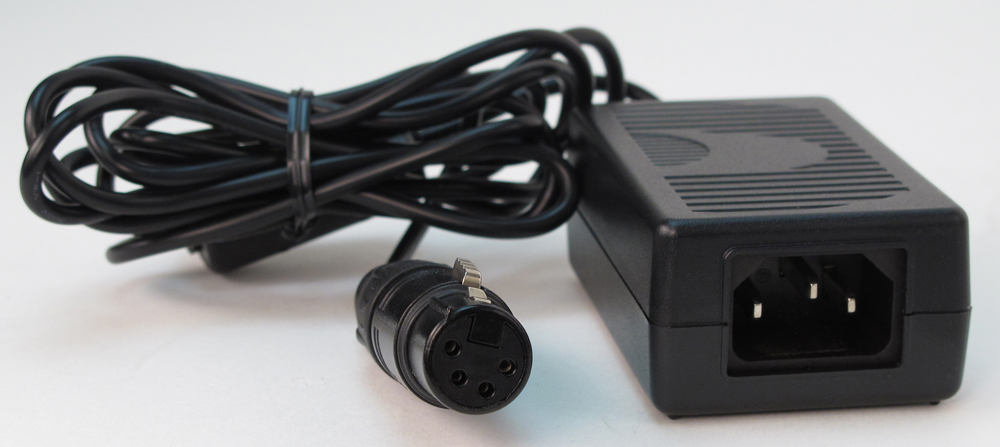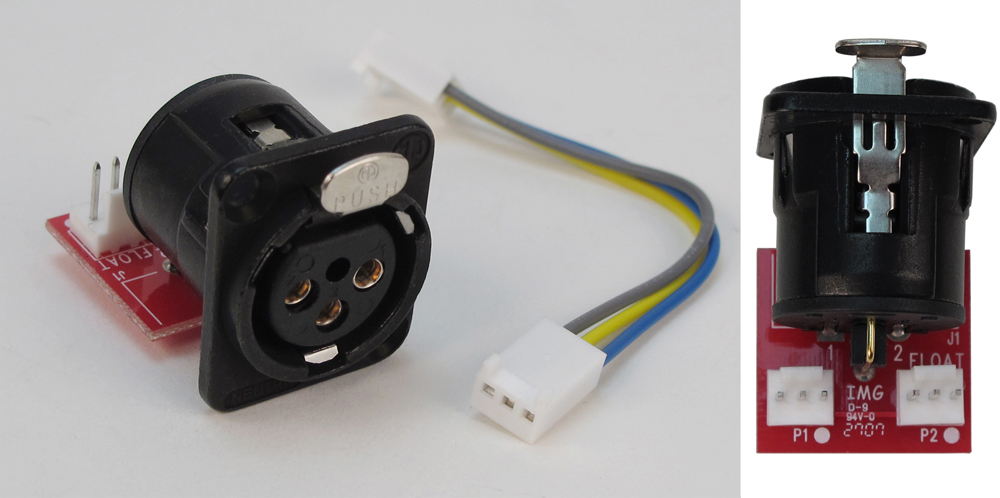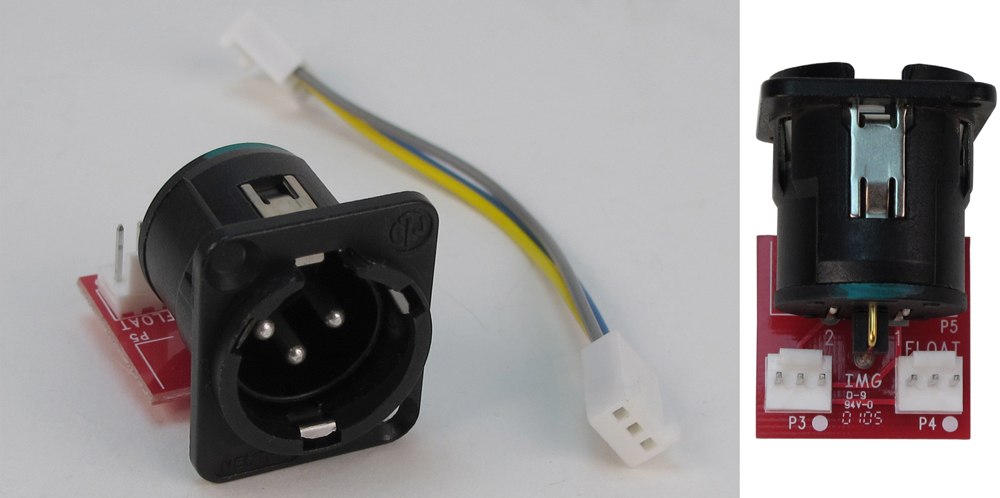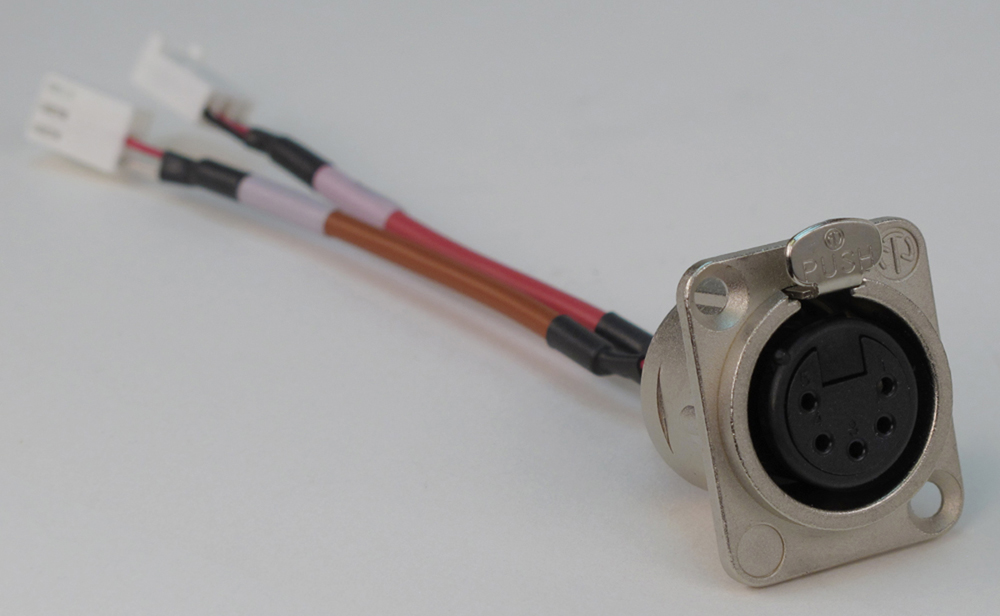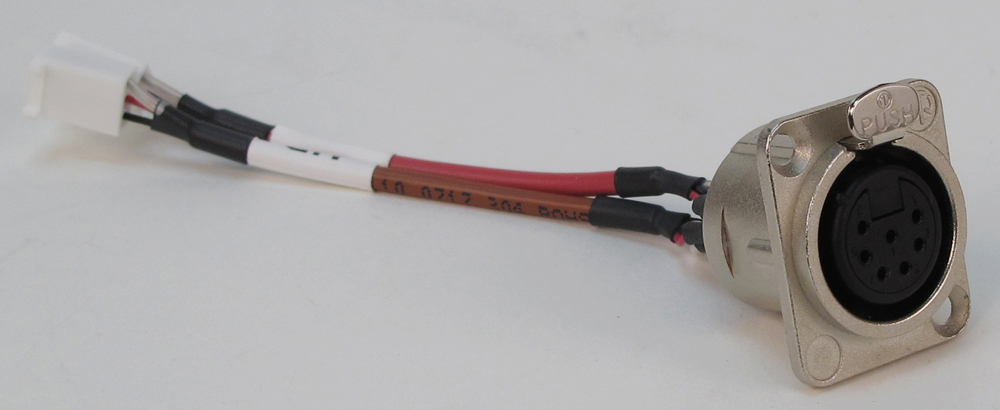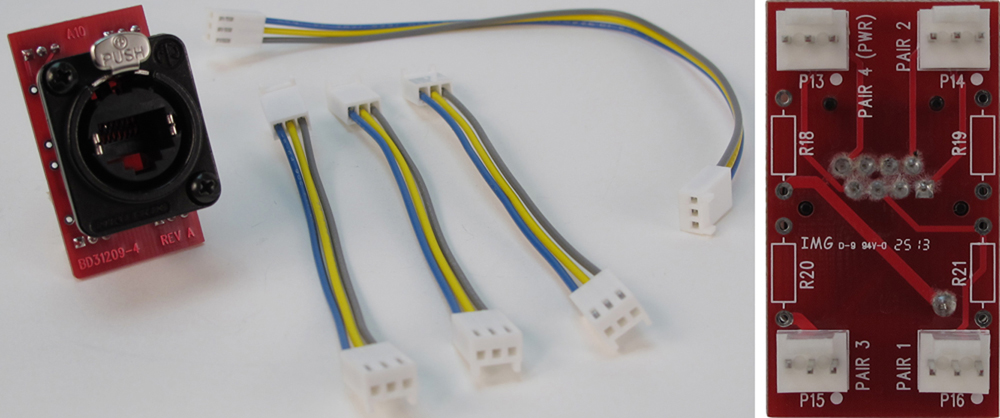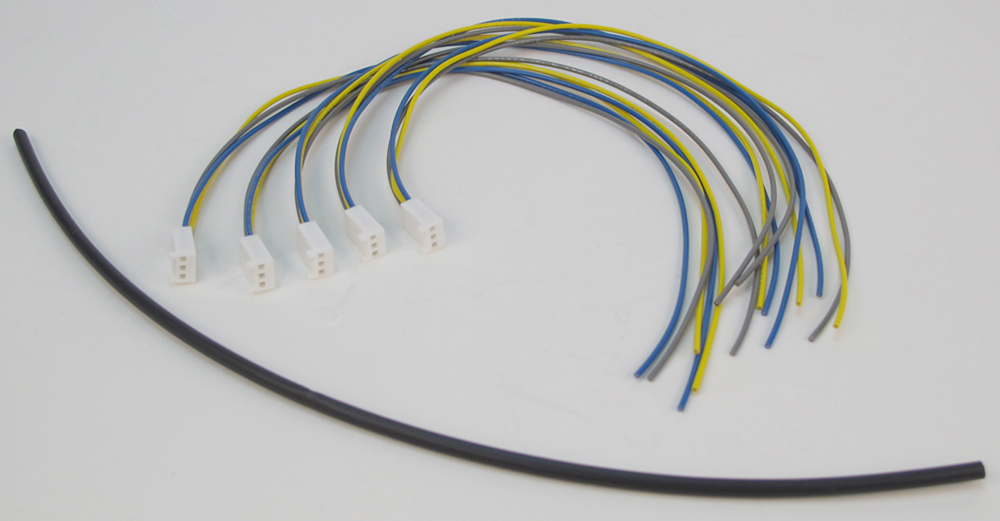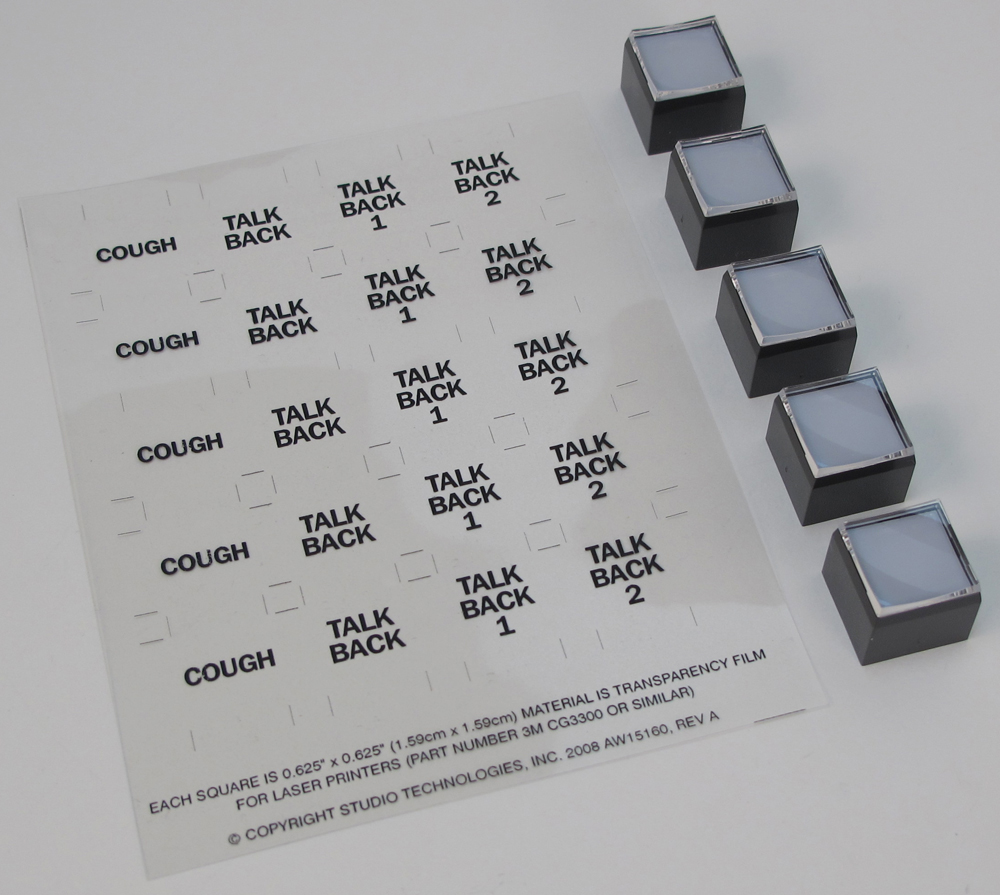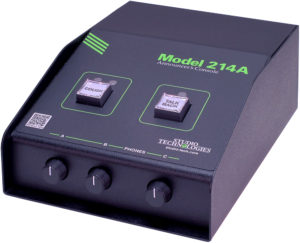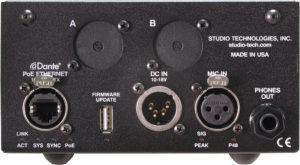The Model 214A Announcer's Console is designed to serve as the audio control center for announcers, commentators, and production personnel. This tabletop unit supports applications utilizing the Dante® audio-over-Ethernet media networking technology. The Model 214A is suitable for numerous applications including on-air television sports broadcasting, stadium announcement, and corporate AV. Two pushbutton switches allow the user to control the main and talkback audio output channels. Ease of use, configuration flexibility, and sonic excellence are some of the unit's highlights.
The Model 214A is compatible with broadcast and audio system environments that use Dante technology. An Ethernet connection with Power-over-Ethernet (PoE) power is all that's required to make the unit part of a sophisticated, networked audio system. Add a microphone and pair of headphones (or a broadcast headset) and the installation is complete. Whether it's the on-air audio, the talkback audio, or the headphone cue feed, superior audio quality is always maintained. Using the STcontroller software application, a range of configuration choices allow the desired operating parameters to be easily selected. And while flexible to configure, the user is presented with an easy-to-understand set of controls and indicators.
User Controls and Status Indicators
Two pushbutton switches, three LED indicators, and three rotary controls provide the user with a clear, easy-to-use interface. One pushbutton switch controls the status of the Dante main transmitter (output) channel. This is the audio channel intended for on-air, announcement, or other primary uses. Two LEDs display the on/off status of the main output channel. A second pushbutton switch controls the status of the talkback Dante transmitter (output) channel. This is the audio signal used to communicate with producers, directors, spotters, or other behind-the-scenes production personnel. A status LED is associated with the talkback pushbutton switch. The two pushbutton switches utilize gold-plated contacts for reliable long-term operation and include backlighting using white LEDs. Three rotary controls allow the user to adjust the content and level of the headphone output channels.
Microphone Input
A microphone signal is connected to the Model 214A by way of a standard 3-pin female XLR connector. The unit incorporates a high-performance microphone preamplifier which offers low-noise, low-distortion, and high-headroom amplification over a 19 to 64 dB range. The gain is adjustable in 3-dB steps. The microphone input is compatible with balanced dynamic or condenser microphones. Phantom power is provided and meets the worldwide P48 standard. A dual-color LED indicator serves as an optimization aid when setting the gain of the microphone preamplifier.
Output Channels and their Operation
By way of the Dante interface, the Model 214A provides a main transmitter (output) channel and a talkback transmitter (output) channel. The main output channel is designed to serve as the on-air, stadium announcement, or other primary audio feed. The talkback output channel is intended to provide production trucks, control rooms, or support personnel with a talent-originated cue signal. In addition to the Dante main and talkback transmitter (output) channels, a third Dante transmitter (output) channel, called aux, is also provided. A configuration choice allows the aux channel to be selected for Hot Mic, Tally Tone, or Main Output with 18 kHz Tone operation.
When selected for Hot Mic, an un-switched audio output whose source is the microphone preamplifier is provided on the Dante aux transmitter (output) channel. This "always active" audio signal could be utilized in an application where the Model 214A is being used in conjunction with an intercom system or audio console. Production personnel may need to monitor the talent audio signal no matter the status of the main or talkback functions.
When selected for Tally Tone operation, a 20 kHz sine wave signal is present on the Dante aux transmitter (output) channel whenever the main output function is active. This tone can be useful as a "trigger" signal for other connected devices that need to provide an indication whenever the Model 214A is actively providing an "on-air" audio signal. For example, a Studio Technologies' Model 391 Dante Alerting Unit can respond to the tally tone signal and provide an "on-air" indicator using its LED display. Alternatively, a Studio Technologies' Model 544D Interface unit could provide a contact closure whenever the tally tone output is active.
Main with 18 kHz Tone provides a unique signal on the aux output. Whenever the Dante main output function is active the signal on the Dante aux transmitter (output) channel will be a combination of audio from the microphone preamplifier and an 18 kHz sine wave tone. This type of signal can be extremely useful in conjunction with REMI/At-Home applications.
A large part of the Model 214A's unique power is the ability to configure the operation of the main and talkback functions. To meet the needs of the many specific broadcast and production applications, a variety of pushbutton switch operating modes are available. The main pushbutton switch can be selected to operate from among five modes. In the Push to Mute mode, the pushbutton performs a momentary mute of the audio signal associated with the Dante main transmitter (output) channel. In this way, a "cough" pushbutton function is created, something typically required for television sports broadcasting. In the Push to Talk mode, the pushbutton switch provides a momentary active function for the Dante main transmitter (output) channel. This mode would be appropriate for an application such as stadium announcement. The Latching (alternate action) mode allows the pushbutton switch to enable or disable the audio signal associated with the Dante main transmitter (output) channel as desired. This is useful in radio broadcasting, announce-booth, or voice-over applications. The fourth mode, Push to Talk/Tap to Latch, provides a hybrid function, supporting both push to talk and tap to enable/tap to disable operation. This operation is similar to that found in many broadcast intercom system user stations. The fifth mode, Push to Mute/Tap to Latch, is a second hybrid function, supporting both push to mute and tap to enable/tap to disable operation.
The pushbutton switch associated with the talkback function can be configured to operate from among three modes. One mode supports a push to talk function. This is typically used for on-air broadcast applications. The second mode provides a latching function. The third mode provides a push to talk/tap to latch function, a hybrid mode that is discussed previously. This mode can be especially useful when the Model 214A is used in production-support applications.
Overall Model 214A operation can be configured from among three modes. One mode is intended for on-air use while the other two can be useful for production applications. The Model 214A's On-Air mode is appropriate for on-air television, radio, and streaming broadcast applications. When on-air is selected the audio signal associated with the Dante main transmitter (output) channel will always mute when the talkback function is active. This prevents audio that's intended for production or support personnel from being sent out the on-air audio path.
For non-on-air applications, the Model 214A can be configured to operate in two production modes. These allow the Dante main transmitter (output) channel to be used as a second talkback channel rather than always muting when the talkback function is active. By utilizing one of these production modes, the unit can be even more powerful when used in a live-event application, supporting personnel serving in roles such as sports-event spotter, musical director, or production assistant. In addition to changing how the Dante main transmitter (output) channel will respond to talkback pushbutton switch operation, one of the production modes also supports using the headphone output for connection with a power amplifier or amplified loudspeakers. In this mode, the headphone output level will automatically be reduced (attenuated or dimmed) whenever the Dante main or talkback transmitter (output) channel is active. This can enhance intelligibility and help prevent acoustical feedback from occurring between loudspeakers and a Model 214A-related microphone.
Headphone Output
The Model 214A provides a number of configuration choices that relate to the unit's 2-channel (stereo) headphone output. These choices include the audio sources that are utilized and how the three rotary level control's function, if and when sidetone action will take place, the minimum headphone output level, and the overall headphone output gain range. Five headphone output audio source and routing modes are offered. These modes impact how the three rotary controls adjust the four Dante receiver (input) channels and the sidetone audio signals.
The first two modes support standard on-air applications and use Dante audio receiver (input) channels 1 and 2. In the broadcast world, these two signals are often referred to as talent cue or IFB audio. In live television applications they typically originate in production trailers or control rooms and provide one channel of program-with-interrupt audio and a second channel with program-only audio. The third, fourth, and fifth configuration modes allow all four of the Dante-provided audio sources to be utilized. These can be useful for more complex or specialized situations.
The three headphone level controls ("rotary pots") are provided for setting the "mix" of the selected audio input sources as well as adjusting the overall headphone output level. How these controls function depend on the selected headphone mode. The first mode can be used to support traditional on-air sports applications. In this mode, it would be typical to route (Dante subscribe) program-with-interrupt audio to the Dante receiver (input) channel 1 and program-only audio to the Dante receiver (input) channel 2. Rotary control A, located on the left side, is used to adjust the level of the program-with-interrupt audio signal that's routed to the left headphone output channel. Rotary control B, located in the center, is used to adjust the level of the program-only audio signal that's routed to the right headphone output channel. For use with dual-channel or stereo cue signals, another headphone output mode provides a stereo ("level/balance") mode. In this mode, rotary control A adjusts the level of both Dante receiver (input) channels 1 and 2, while rotary control B allows adjustment of the left/right level balance. In both of these modes, rotary control C, located on the right side, is used to adjust the level of the sidetone audio signal that can be sent to both the left and right headphone output channels.
When selected for the third headphone output mode rotary control A adjusts the level of Dante receiver (input) channel 1 as it is sent to the left headphone output channel and Dante receiver (input) channel 2 as it is sent to the right headphone output channel. Rotary control B provides the same function for Dante receiver (input) channels 3 and 4. Rotary control C adjusts the sidetone level. The fourth headphone output mode offers another unique routing choice. Rotary control A adjusts the level of Dante receiver (input) channel 1 as it is sent only to the left headphone output channel. Rotary control B adjusts the level of Dante receiver (input) channel 2 as it is sent only to the right headphone channel. Rotary control C adjusts the level of Dante receiver (input) channels 3 and 4 as they are sent, respectively, to the left and right headphone output channels.
The fifth headphone output mode is similar to the fourth, with the exception that Dante receiver (input) channel 1 is sent to both the left and right headphone output channels; Dante receiver (input) channel 2 is sent to both the left and right headphone output channels.
The sidetone function allows audio from the output of the Model 214A's microphone preamplifier to be sent to the left and right headphone output channels. This can be useful, providing the user with an aural confirmation of the signal connected to the microphone input. This ability can be especially important when a "mix-minus" talent cue signal is provided for the user. For application flexibility, the sidetone function can be configured from among four choices, specifying when it will be active in relation to the status of the main and talkback functions. It can also be disabled if desired.
To help minimize the chance of broadcast cues being missed, the action of the rotary level controls can be configured so that there's always a minimum headphone output level. Alternately, the rotary controls can be configured to fully mute when the controls are at their minimum (fully counterclockwise) position. When the rotary level control on the right side, labeled C, is configured for sidetone use it will always allow the sidetone signal to be fully muted.
The 2-channel (stereo) headphone output was designed to meet the needs of contemporary headphones and headsets. Specifically, the two output circuits act as voltage drivers rather than power drivers. In this configuration, they can provide high output levels with very low distortion and noise, along with minimal current consumption. With the Model 214A, all types of headphones, headsets, and earpieces can be directly connected.
A configuration feature allows the overall headphone output gain range to be selected. The low setting is appropriate for most applications where users need to listen at moderate levels. The high setting can be useful when monitoring at higher levels is warranted by an application
Dante Audio-over-Ethernet
Audio data is sent to and from the Model 214A using the Dante audio-over-Ethernet media networking technology. For flexibility in meeting a variety of application and sonic requirements, bit depths of up to 24 and sample rates of 44.1 and 48 kHz are supported.
Audio transmitter (output) and receiver (input) channels on associated Dante-enabled devices can be routed (Dante subscribed) to the Model 214A using the Dante Controller software application. This makes selecting the way in which the Model 214A fits into an application a simple matter. For example, the Dante main transmitter (output) channel can be routed to the Dante receiver (input) channel of an audio console. The Dante talkback transmitter (output) audio output channel could be routed to a Dante receiver (input) channel on a matrix intercom system. The Dante aux transmitter (output) channel, when configured for Hot Mic, could be routed directly to an amplified speaker for producer or director use. No special assignment or "multing" using cables or patch points is necessary to send a Dante transmitter (output) channel to Dante receiver (input) channels of multiple destinations — only a single mouse-click is required to reroute or assign a Dante audio signal.
On its input side, the Model 214A allows up to four headphone cue sources to be received from an audio console, matrix intercom system, or a variety of other Dante-enabled devices (the sources don't need to originate from the same device although there is a limit of two). In this way, program audio could be supplied by an audio console while program-with-interrupt audio could be supplied by a matrix intercom system.
Ethernet Data, PoE, and DC Power Source
The Model 214A connects to a data network using a standard 100 Mb/s twisted-pair Ethernet interface. The physical interconnection is made by way of a Neutrik® etherCON RJ45 connector. While compatible with standard RJ45 plugs, etherCON allows a ruggedized and locking interconnection to meet the needs of harsh or high-reliability environments. The Model 214A's operating power can be provided by way of the Ethernet interface using the Power-over-Ethernet (PoE) standard. This allows fast and efficient interconnection with the associated data network. To support PoE power management, the Model 214A's PoE interface reports to the power sourcing equipment (PSE) that it's a class 2 (low power) device. (In PoE parlance, the Model 214A is a standard PD (powered device).) The unit can also be powered using an external source of 12 volts DC. For redundancy, both power sources can be connected simultaneously. If both sources are connected, PoE will power the unit. Four LEDs, located on the back panel, display the status of the network connection, PoE power source, and Dante interface.
Configuration Flexibility
The Model 214A can be configured to meet the needs of specific applications and user preferences. All configuration tasks are performed using the STcontroller personal computer software application, available free of charge on the Studio Technologies' website. (Versions of STcontroller that are compatible with the Windows® and macOS® operating systems can be downloaded.) In the Model 214A there are no mechanical switch settings or button-press sequences required to configure how the unit functions. Selectable parameters include microphone preamplifier gain, P48 phantom power on/off, input channel routing and headphone output performance, sidetone operation, pushbutton switch operation, and overall operating mode. Changes made to any of the configuration parameters become active immediately.
The gain of the microphone preamplifier can be selected in 3-dB steps over a 19 to 64 dB range. This allows the Model 214A to match the output sensitivity of a variety of handheld and headset-associated microphones. A low-noise source of P48 phantom power can be enabled if required to support condenser microphones. The four Dante receiver (input) audio channels and the way in which they are assigned to the headphone output channels can be configured. This configuration includes how the three rotary controls (pots) function. These five unique choices allow almost any required headphone monitoring situation to be implemented. Whether for use in on-air sports, in stadium announcement applications, or as a production support tool, the Model 214A should be able to achieve the desired configuration. The integrated sidetone function can be configured to operate from among three choices. This allows audio associated with the output of the microphone preamplifier to be sent to the headphone output channels as required. Sidetone can be important as some applications may provide a "mix-minus" talent cue signal that doesn't include the user's own voice content. A configuration selection allows the operation of the pushbutton switch and its associated function to be selected from among five choices. The talkback button can be configured from among three choices.
Customization
In the world of broadcast and production audio it's fair to say that applications vary widely. To this end, one or two additional XLR connectors can easily be mounted into the Model 214A's back panel. Multiple 3-position headers, located on the Model 214A's circuit board, provide technician access to microphone, headphone, pushbutton switch, and relay connections. Using a variety of optional factory-supplied connector and interface cable kits allows a Model 214A to be optimized to meet the needs of specific applications. For example, some applications may prefer to use a multi-pin XLR connector to interface with a headset. This can easily be accomplished by installing the appropriate 6- or 7-pin XLR connector kit and making a few simple connections. Other applications may benefit from having "mult" or "loop-through" connections, something easily incorporated into a Model 214A. External contact closures to activate the main and/or talkback functions can be interfaced using a 4-pin XLR connector kit.
Two general-purpose relay contacts are provided on the Model 214A's circuit board. Accessible using 3-pin header connectors, they allow specialized configurations to be created. Under software control, the form-A (normally open) solid-state relay contacts can be configured to follow the state of the main and talkback functions. Taking advantage of the two locations provided for additional XLR connectors, a technician may easily implement a variety of functions such as a tally indication or audio muting during talkback.
Future Capabilities and Firmware Updating
The Model 214A was designed so that in the future its capabilities and performance can be easily enhanced. A USB type A receptacle, located on the unit's back panel, allows the operating firmware (embedded software) to be updated using a standard USB flash drive. The Model 214A uses Audinate's Ultimo™ integrated circuit for implementing Dante. The firmware within this integrated circuit can be updated via the Ethernet connection, helping to ensure that its capabilities remain up to date.

